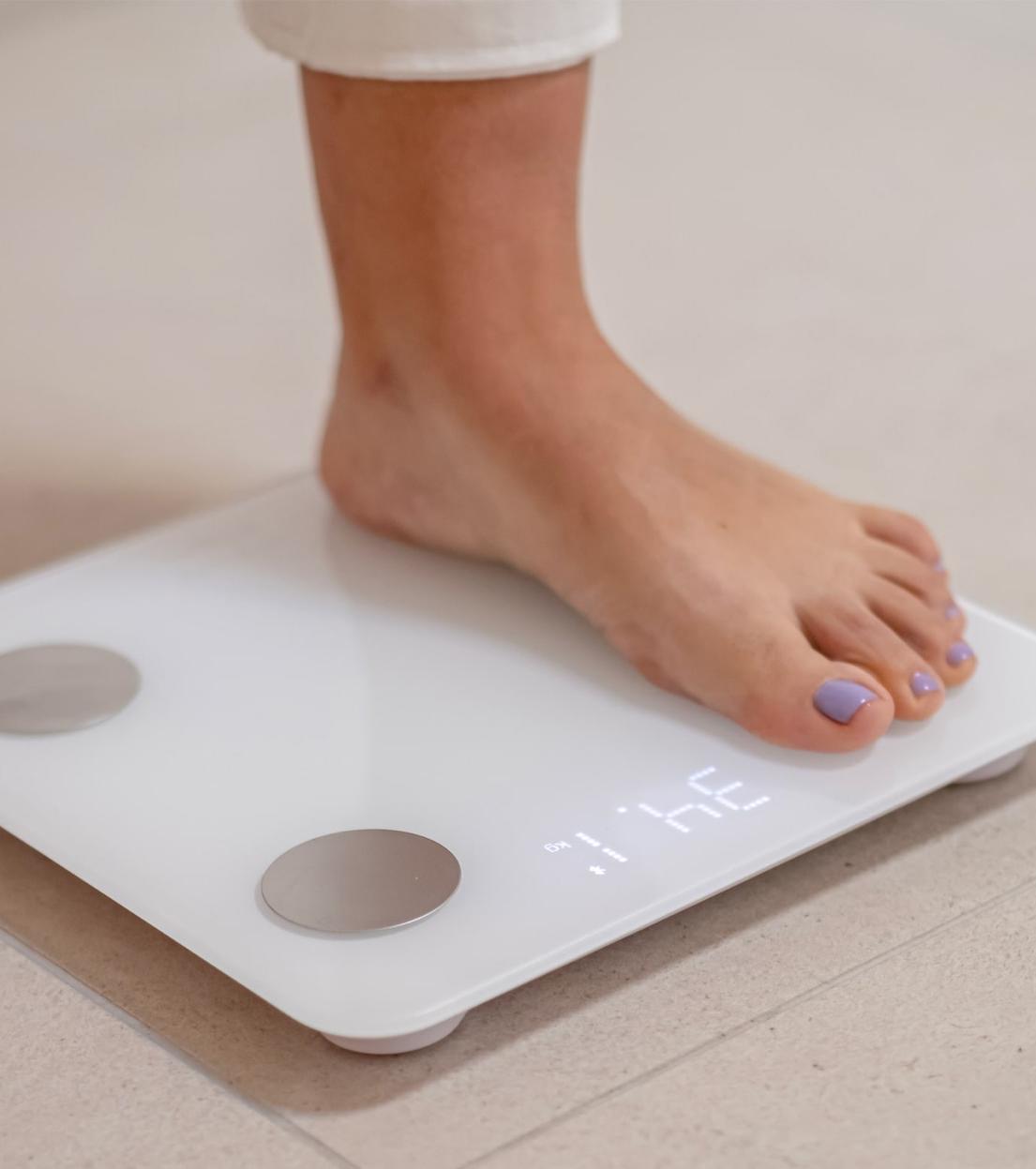A COMPLETE UNDERSTANDING
Powerful insight from inside
While it is good to know your weight, there is so much more your body can tell you. In just one step, the Leggera 2 Smartscale measures your weight - and much more! Leggera captures 19 different measurements related to your body composition.
HELO SMART APP
Track every metric and improve
Leggera shares this data with the Helo Smart App on your smartphone, making it simple and convenient to track your progress. Now you can know if building muscle has paid off, or if you need to increase your calorie burn to reduce fat.
With Leggera 2, you’re already one step closer to meeting your health and wellness goals.
A Total Body Assessment through BIA
BIA is a proven, non-invasive measurement method that uses a weak electrical current that passes through the body - and you don’t even feel it. Based on how the body reacts to the current, BIA can measure water, fat, bone, and muscle in your body.
In seconds, Leggera captures 19 different measurements of your body composition
Water
TBW (Total Body Water)
The total water present in the body. Water is the predominant component in the human body; it represents about 60% of the weight of an adult (at birth it is about 77% and decreases with age and with the accumulation of adipose deposits). Its metabolism is closely linked to sodium, which holds it back.
ICW (Intra Cellular Water)
The amount of intracellular water is closely related to the metabolically active cell mass of an organism, and therefore this parameter reflects the development and growth of body cell mass. Cells tend to retain fluids within themselves to preserve their integrity. The right amount of minerals, among other things, also protects cells from damage caused by free radicals (and oxidative stress), to help cells stay young for longer.
ECW (Extra Cellular Water)
The volume of fluid that is outside the cell. It reflects the state of body hydration. From this percentage, it is possible to identify states of dehydration or water retention.
Cellular
BCM (Body Cellular Mass)
Represents the metabolically active component of the Fat Free Mass (FFM; the other component of the FFM is the ECM). It is composed of the living cells of the organism which consume oxygen and carry out redox reactions. It contains almost all of the body's potassium. Each person has a minimum BCM below which it is not recommended to go due to a decrease in both lean muscle mass and metabolism. It is a fundamental value that must be monitored over time, and which allows us to understand whether the person is malnourished or not.
ECM (Extra Cellular Mass)
Made up of extra-cellular tissues, i.e. plasma, fluids, tendons, dermis, collagen, elastin and skeleton. The ECW is the predominant component of the ECM. High values indicate water retention. In standard measurement, it must be less than or equivalent to the MC. Some diseases tend to decrease CD. In case of water retention, the MC may be normal but the ECM is high. The ECM also increases in correlation with rapid weight gain. Conversely, in states of dehydration, by losing extracellular fluids, the ECM is also lowered.
ICM (Intra Cellular Mass)
Inert mass of the FFM, with a zero metabolic cost.
Na/K (Sodium/Potassium Exchange)
A very important value that indicates the functioning of the cell membrane for the assimilation of nutrients, the elimination of metabolic waste, and muscle functioning. Abnormal values can cause cramps or muscle spasms, fatigue, and irritability and indicate suboptimal metabolic functions. Potassium alters muscle contractions. To improve the sodium/ potassium ratio, one should increase the potassium intake and optimize metabolic activities to increase the intake of vitamins. By also increasing the supply of mineral salts, damage caused by free radicals can be prevented.
Mass
FM (Fat Mass)
Excess fat causes the onset of numerous diseases (heart disease, hypertension, respiratory failure, type 2 diabetes, etc.). To decrease it, the calorie intake must be lower than those used.
FFM (Free Fat Mass)
Lean mass is muscle tissue: it is rich in water (about 60%) and greatly influences the metabolism. In fact, the more muscle mass one has, the more calories one burns, both at rest and in activity.
FFMS (Free Fat Mass Muscle)
Related to the weight of the part of the lean mass that makes up the muscular fiber. There is an important role in the migration of the basic metabolism, protecting the internal organism, the organization, migrating the cardiovascular function, etc.
VSCR (Visceral Fat)
Reflects the degree of abdominal fat accumulation. Keeping the index constant can significantly reduce the risk of heart disease, hypertension, and hyperlipidemia.
SKTL (Skelton)
Refers to the content of bone tissue (bone minerals such as calcium, phosphorus, etc.) and the bone matrix (collagen, proteins, inorganic salts, etc.). It can indicate the state of health of the bones.
Indexes
BCMI (Body Cellular Mass Index)
Represents the energy used by the body in conditions of mental and physical rest, in the supine position, fasting for 12 hours, with an ambient temperature of 20 °C. It is measured in kCal or kJ. BCMI will changes in relation to age, body surface area, muscle mass, climate, nutrition, fever, and drugs or medications.
BMI (Body Mass Index)
The ratio of weight (in kg) to height (in meters) squared.
PA (Phase Angle)
The relationship between Reactance and Resistance is defined as Phase Angle: 0° would indicate a body made up of liquids only, while 90° equates to cell membranes only. Both cases are impossible.
Metabolism
BMR (Basal Metabolism Rate)
Represents the energy used by the body in conditions of mental and physical rest, in the supine position, fasting for 12 hours, with an ambient temperature of 20 °C. It is measured in kCal or kJ. BCMI will changes in relation to age, body surface area, muscle mass, climate, nutrition, fever, and drugs or medications.
PF (Protein Factor)
Proteins are indispensable in the human body and play numerous roles. They supply the body with the amino acids necessary for tissue renewal processes; they are repositories of the genetic code (DNA and RNA); they act as transporters of the various substances present in the blood; they act as neurotransmitters and are the basis of many hormones; they intervene in blood coagulation; they are necessary for muscle contraction; they are essential for immune defense; they are precursors of enzymes that regulate the speed of reactions and that intervene in the various metabolisms of the body; marginally, they also have an energetic function.
Ideal Weight
IW (Ideal Weight)
Calculated as the average of four well-known literature formulas: Broca, Van Der Wael, Perrault, and Keys.
Risks
CVR (Cardio Vascular Risk) A statistical index that allows probabilistic evaluation in developing a cardiovascular problem. It is based on evident empirical studies that consider 8 factors: age, reactance, BMI, biotype, waist circumference, exercise, pathologies, and metabolism. The assumed values range from 0 to 8 and are interpreted as: LOW: <= 2, MEDIUM:> = 3 <= 5, HIGH:> = 6.
Biotype
Android/Gynoid Android fat storage describes the distribution of fat mostly around the trunk/abdomen area (referred to as 'central' fat storage) or the upper body. Due to this type of distribution, those exhibiting excess android fat patterns will resemble an apple shape, where the fat storage pattern is typical in males. Gynoid fat pattern is characterized by the accumulation of excess fat around the hip, buttocks and thigh regions. Due to this type of distribution, excess gynoid fat patterns will resemble a pear shape, where the buttocks and hips are much larger than the waist. This type of distribution is typical in females (the term gynoid relates to the female form). Gynoid fat is generally stored 'subcutaneously' which means that fat stores on the surface of the body, just under the skin and above the muscle.

By itself, Leggera calculates body composition for the lower torso and legs. The Helo LifeWatch Generation 2 calculates for the upper body and arms. When used together, you can enjoy a complete and highly accurate body composition measurement.
Your Leggera syncs your data with the Helo Smart App, making it simple and convenient to monitor your metrics and your progress in making improvement.
Please note that some features are not available in all markets


